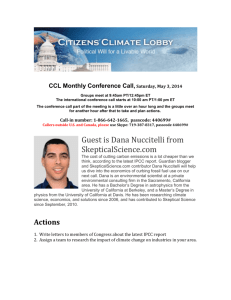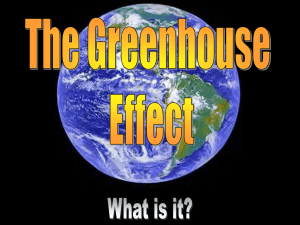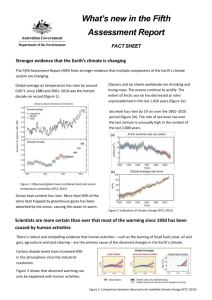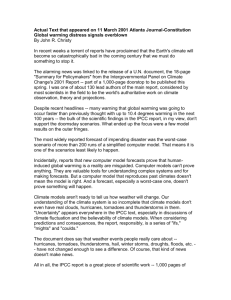Climate Change and Its Consequences
advertisement
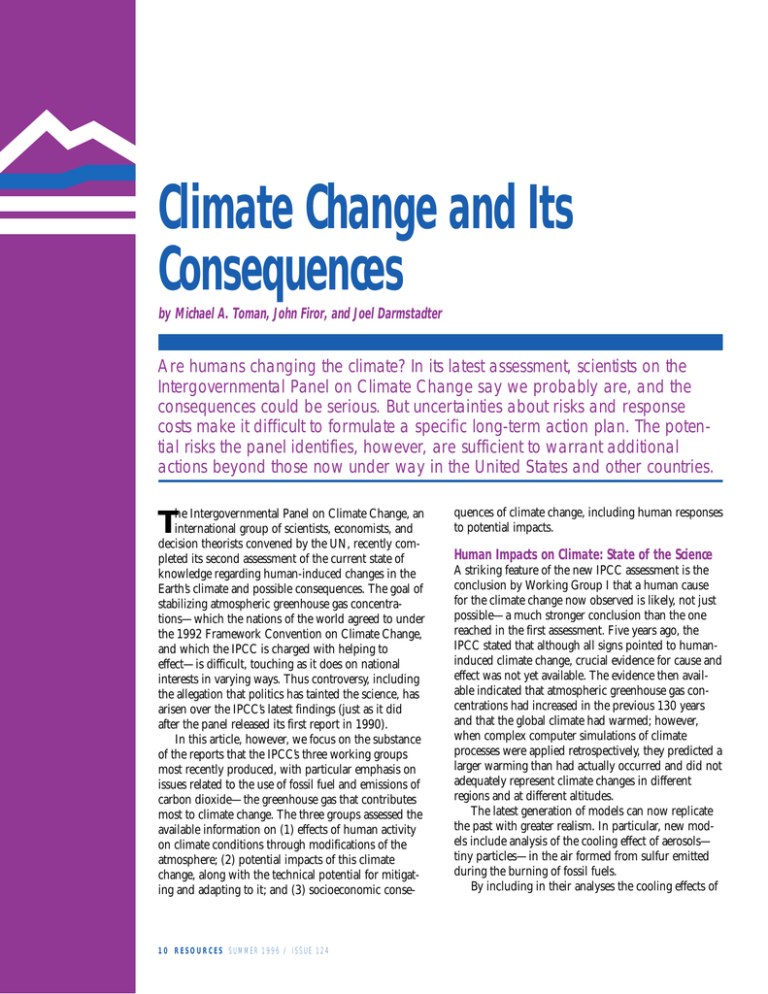
Climate Change and Its Consequences by Michael A. Toman, John Firor, and Joel Darmstadter Are humans changing the climate? In its latest assessment, scientists on the Intergovernmental Panel on Climate Change say we probably are, and the consequences could be serious. But uncertainties about risks and response costs make it difficult to formulate a specific long-term action plan. The potential risks the panel identifies, however, are sufficient to warrant additional actions beyond those now under way in the United States and other countries. he Intergovernmental Panel on Climate Change, an T international group of scientists, economists, and decision theorists convened by the UN, recently completed its second assessment of the current state of knowledge regarding human-induced changes in the Earth’s climate and possible consequences. The goal of stabilizing atmospheric greenhouse gas concentrations—which the nations of the world agreed to under the 1992 Framework Convention on Climate Change, and which the IPCC is charged with helping to effect—is difficult, touching as it does on national interests in varying ways. Thus controversy, including the allegation that politics has tainted the science, has arisen over the IPCC’s latest findings (just as it did after the panel released its first report in 1990). In this article, however, we focus on the substance of the reports that the IPCC’s three working groups most recently produced, with particular emphasis on issues related to the use of fossil fuel and emissions of carbon dioxide—the greenhouse gas that contributes most to climate change. The three groups assessed the available information on (1) effects of human activity on climate conditions through modifications of the atmosphere; (2) potential impacts of this climate change, along with the technical potential for mitigating and adapting to it; and (3) socioeconomic conse- 10 RESOURCES SUMMER 1996 / ISSUE 124 quences of climate change, including human responses to potential impacts. Human Impacts on Climate: State of the Science A striking feature of the new IPCC assessment is the conclusion by Working Group I that a human cause for the climate change now observed is likely, not just possible—a much stronger conclusion than the one reached in the first assessment. Five years ago, the IPCC stated that although all signs pointed to humaninduced climate change, crucial evidence for cause and effect was not yet available. The evidence then available indicated that atmospheric greenhouse gas concentrations had increased in the previous 130 years and that the global climate had warmed; however, when complex computer simulations of climate processes were applied retrospectively, they predicted a larger warming than had actually occurred and did not adequately represent climate changes in different regions and at different altitudes. The latest generation of models can now replicate the past with greater realism. In particular, new models include analysis of the cooling effect of aerosols— tiny particles—in the air formed from sulfur emitted during the burning of fossil fuels. By including in their analyses the cooling effects of RESOURCES FOR THE FUTURE aerosols and stratospheric ozone depletion, most of the latest studies have detected a significant climate change and, in the conclusion reached by Working Group I, show that the observed warming trend is “unlikely to be entirely natural in origin.” The balance of evidence suggests a “discernible human influence on global climate.” Despite recent improvements, climate models are still unable to project the details of climate change on a regional scale, complicating assessment of potential impacts and response options. A further complication is the possibility that future climate change will be neither gradual nor continuous, but abrupt and surprising, as Working Groups I and II caution repeatedly. Potential Natural Impacts What constitutes a “dangerous” level of interference with the climate is a complicated question. In its latest assessment, the IPCC addresses many impacts of climate change, including the effects on agriculture, forestry, terrestrial and marine ecosystems, hydrology and water resource management, human health, human infrastructure, and financial services. While the potential impacts of climate change are broad, some aspects of human society are more sensitive than others. In particular, more highly managed systems like agriculture, where skills and resources for investing in adaptation are available, may be less sensitive than less managed systems like wilderness areas. However, some of the adverse effects of climate change may fall disproportionately on poorer, less-adaptive parts of the world. The IPCC puts greater emphasis than it has in the past on the potential adverse effects of climate change on human health. Periods of sustained higher temperatures not only could increase mortality but also foster the spread of disease through greater water contamination and a wider geographic dispersion of diseasecarrying organisms such as mosquitoes. The ability to quantify future damage and adaptation potential varies greatly across sectors. The physical consequences of a given magnitude of sea level rise, or the impacts of climate change on agricultural yields and forest conditions, can be projected with higher confidence than, say, impacts on wetlands and fisheries. Yet even when confidence is high that a certain effect will occur if climate changes, its magnitude cannot be predicted precisely. Working Group II also points out that damage to ecosystems and human structures arising from such other causes as population growth, industrial expansion, and changes in land use could combine with effects of climate change to push already stressed systems “over the edge.” Particularly if climate change were very rapid, damage could be severe and longlived, perhaps irreversible. However, such rapid change may be unlikely and is difficult to predict. Socioeconomic Consequences Decisionmakers contemplating public policies to deal with climate change need to understand the socioeconomic consequences that might follow from the physical and biological impacts of climate change. Uncertainties about these consequences are compounded not only by remaining scientific questions but also by diverse views about how socioeconomic consequences should be defined and measured. The latest IPCC assessment notes the practical limits of conventional benefit-cost analysis as applied to climate change issues. Climate change involves risks of natural impacts that would be very long term, spanning multiple generations. Moreover, these impacts could be very large in scale and not so readily offset by substituting other capital investments. Such risks are not easily incorporated into conventional benefit-cost analysis. Nevertheless, Working Group III rightly asserts that an economic benefit-cost assessment can help guide decisionmaking when coupled with an assessment of other factors. These include impacts that are not easily monetized and the distributional effects of climate change within and across generations. In reviewing the available evidence on the economic impacts of climate change, Working Group III looked at a number of potential effects. These include impacts on agriculture and forestry, effects on water supplies, damages from sea-level rise to coastal areas and expenditures to protect them, increased mortality risks, effects on fisheries and wetlands, and effects of changes in conventional air and water pollutants. But the group’s assessment was not exhaustive. For lack of data, several important impacts of possible climate change either were only partly addressed or not addressed at all. These include broad ecosystem damages and the consequences of increased nonfatal illnesses. Moreover, the estimates reflect individual SUMMER 1996 / ISSUE 124 RESOURCES 11 C L I M AT E C H A N G E damage components, without fully accounting for the effects of multiple stresses brought on by forces other than climate change. The estimates also are based primarily on a single scenario in which the global climate has reached equilibrium after a doubled atmospheric CO2 concentration. This formulation does not capture the cost of adjusting to climate change or the possible consequences of even higher greenhouse gas concentrations. Aggregate damage estimates under these assumptions, expressed as a percentage of GDP to provide a sense of scale, tend to cluster around 1 to 1.5 percent for advanced industrial economies and 2 to 9 percent for developing countries. For some individual countries—say, small island states subject to flooding from sea-level rise—substantially higher costs could be incurred. Clearly, a number of thorny issues related to adaptive capacity and equity lie beyond estimates of aggregate damages. The range of estimates for individual types of damage is wide, and the assessment recognizes the possibility of benefits, such as a longer growing season in some locations (leaving aside the costs of adjusting to climate change). Moreover, all damage figures are point estimates, lacking probability ranges or confidence intervals, and in many cases the estimates are simply educated guesses. Effectiveness and Cost of Response Options Emissions of CO2—almost all generated by burning fossil fuel—account for about two-thirds of all enhanced heat trapping by greenhouse gases. Greater efficiency in the conversion and use of energy would obviously slow emissions, but no meeting of the minds exists on what it would cost to increase energy efficiency. Indeed longstanding differences of opinion about that cost enter into the IPCC’s debate over the cost of reducing greenhouse gas emissions. Some analyses reviewed by the IPCC indicate that decreases in energy use of 10 to 30 percent can be achieved at low or even negative cost by widespread adoption of technologies that people do not use now because of such market barriers as lack of information, uncertainty about product performance or lifetime costs, high up-front costs, the distorting effect of energy subsidies, and the “chicken and egg” problem created by low initial purchase volume and high initial price. By reducing these barriers, the argument goes, 12 RESOURCES SUMMER 1996 / ISSUE 124 government policies could reduce greenhouse gas emissions very cheaply. Economists accept the idea that energy and other markets do not always work effectively, which certainly is the case in many countries. But many economists remain skeptical that the apparent lack of interest in more energy-efficient products necessarily is a market failure, citing other explanatory factors such as customer dissatisfaction with some product attribute that overwhelms consideration of its energy efficiency. Accordingly, some of the analysts whose studies Working Group III surveyed do not believe barriers to widespread adoption of technologies are a major problem, at least in advanced economies where markets generally work, or that their elimination offers a truly cost-effective way of lowering mitigation costs. Thus their estimates of these costs are often higher than the technological state of the art would imply. For example, these latter analyses suggest that the cost to OECD countries of stabilizing carbon dioxide emissions at 1990 levels over the next several decades could range from -0.5 percent (a small net increase in GDP) to as much as 2 percent of GDP. (In evaluating these estimates, it is important to keep in mind the fact that GDP is not an accurate measure of social well-being.) Moreover, these estimates tend to assume use of the most cost-effective emissions control policies, such as carbon taxes or emissions trading. If the policies put in place were actually less cost-effective, the estimated economic burden would increase. Regardless of one’s position in this debate, an important conclusion to arise from Working Group III’s review is that the total costs of meeting a longterm target for reducing greenhouse gas concentrations in the atmosphere may be reduced substantially by stretching out the time period of emission reductions and providing emission sources with flexibility in the timing of reductions. Such flexibility could cushion abatement costs by reducing premature obsolescence of existing capital and permitting greater development and deployment of new, efficient technologies. With regard to the eventual necessity for global participation in curbing greenhouse gas emissions, the IPCC notes the tension between that ideal and the need to respect the economic development priorities of the world’s lower-income countries. Yet by meeting those priorities, poorer countries might expand their RESOURCES FOR THE FUTURE capacity to cope with climate change stresses, in addition to raising their living standards. If fairness and implementation issues can be resolved, the IPCC points out that significant opportunities exist for international cooperation to lower the costs of emission reductions. These opportunities include “joint implementation” projects in which richer countries make investments in reducing emissions in poorer countries. Properly structured, such projects can convey tangible economic and environmental benefits to recipient countries while lowering the total costs of greenhouse gas emission reductions. As for permitting countries some flexibility as to when and where emissions are reduced, while it is true in principle that such flexibility can increase economic efficiency, in practice the ability to do so may be constrained by political considerations. Permitting delays in emissions reductions may lack credibility because of skepticism that governments will honor previously made commitments to pursue aggressive reductions. Developing countries also have expressed suspicion about the motivations for joint implementation and a desire for more concrete action by developed countries themselves. To overcome these concerns may require developed countries to carry out greater and more immediate emissions reductions than a simple analysis of economic efficiency would indicate. The IPCC assessment also considers the way in which adaptation measures—for example, improved water management—can contribute to both economic efficiency and increased resiliency to weather fluctuations and climate change. Indeed, given the IPCC’s conclusion that some climate changes have already been set in motion, some adaptation is already essential as well as desirable in order to avoid some of the costs of mitigation. More detailed attention to adaptation is needed in future assessments, however. Final Comments Based on the insights, information, and findings of the IPCC’s second assessment, it is now much more difficult to argue that human activities are not changing the climate. It is also now easier to argue that the impacts of climate change may be substantial, surprising, and unfair. Unfortunately, the continuing uncertainties about the scale and nature of climate change, its consequences, and the costs of response make it difficult to specify a long-term plan of action at this time. Legitimate debate continues about what constitutes— and how best to avoid—a “dangerous” interference with the climate system. For our part, we believe that the latest IPCC assessment justifies some degree of policy intervention that goes beyond actions to improve economic efficiency without reference to climate change, although neither the United States nor the other industrialized nations have yet to exhaust all opportunities for these “noregrets” actions. While the potential risks are difficult to quantify, the IPCC assessment strongly suggests that they are not zero. Given that society is not impervious to risks, some anticipatory efforts to reduce threats as well as efforts to improve the understanding of their magnitude are called for. The task is not easy. The second assessment underscores the challenge of understanding and responding to the ecological and socioeconomic aspects of climate change and other closely intertwined global problems, as well as the need for further understanding of how the climate is affected by human activities. Climate scientists need to focus on the regional manifestations of climate change and the variability of these changes; impact studies must become more quantitative and effective adaptations need to be better identified; and economists must extend and supplement their tools for assessing the consequences of global change and the costs of policy responses. The opportunities, as well as the needs, for new approaches in these fields are substantial. To reap these opportunities, governments and other sources of research funding should maintain or increase their budgets for climate change analysis, and a greater share of future research budgets should be allocated to ecological and socioeconomic research. Michael A. Toman and Joel Darmstadter are senior fellows in RFF’s Energy and Natural Resources Division. Until recently, John Firor headed the Advanced Study Program at the National Center for Atmospheric Research, where he is now a senior research associate. Find out more about the IPCC at http://www.unep.ch/ipcc/ipcc-0.html. To order bound copies of the latest available working group reports, contact Cambridge University Press, Dept. PJL, 40 West 20th St., NY, NY 10011-4211; fax: 212-691-3239. SUMMER 1996 / ISSUE 124 RESOURCES 13

